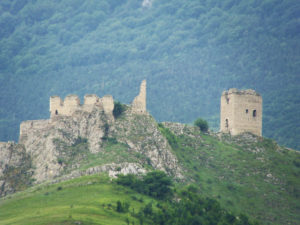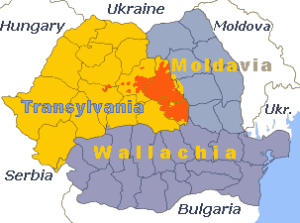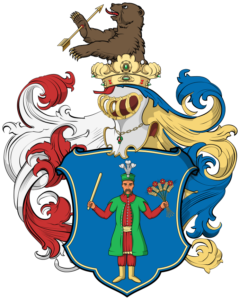Torockószentgyörgy

Torockószentgyörgy (Coltești, Sankt Georgen) is located in Transylvania, Romania. It is near the miners’ settlement of Torockó (Rimetea, Eisenburg). It was once part of Torda County, and it is situated not far from the banks of the Maros (24 km) and Aranyos rivers (9km). Its castle stands opposite a summit called Székelykő (Székely Stone), which is on the other side of the valley.
Location: https://tinyurl.com/3dfavud9
Nothing is known for certain about the history of Torockó before 1241. It is possible that its origins were connected with the logging of the area, which was linked to the transport of salt on the Maros. It cannot be excluded that iron ore mining, so characteristic of Torockó, also started in this period. The settlement was built after the Mongol invasion of 1242.
Look at this video about its development:
https://www.youtube.com/watch?v=5KQKSyjMUag

Torockó and Torockószentgyörgy, the two settlements, are closely linked to the Aranyos region to the east, a link that has been established since the end of the 13th century by the castle built on Székelykő. Although there are many differences between the two settlements, from the structure of the settlement to the way of life of the inhabitants, their history is closely intertwined, and it is impossible to imagine one without the other. Torockó and Torockószentgyörgy thus embody a harmonious unity of contrasts and interconnections. Even today, there are two isolated Hungarian settlements in predominantly Romanian countryside.

At the second Mongolian invasion in 1285, this was a sparsely populated area. When the Tatars attacked it, they wreaked havoc. The families made great efforts to settle their estate here, and as a result, the villages of the area were established one after the other. Their number increased to ten in the 15th century. Here is more about the Székely people:
https://www.hungarianottomanwars.com/essays/who-were-the-szekelys/

Torockószentgyörgy, near Torockó, was probably one of the earliest settlements in the area, separated from Torockó by the patron saint of its church. King István the Younger (1257-1270), considered the ‘second founder’ of Transylvania, decided to settle Székelys on the land of Aranyos, bordering the Torockó estate to the east, as part of this settlement policy. This later grew into Aranyosszék.

The story of the castle begins with the fact that the neighboring Torockó also had a castle, so it is often impossible to know exactly when and which castle is mentioned in old writings and documents. Furthermore, it doesn’t make it any easier for travelers that there is no information besides the castle, apart from a semi-illegible plaque from the 1800s.

The castle is associated with the Thoroczkay (or Toroczkai) family, who once belonged to the Clan of Ákos. The first known male member of the Torockai family was Ehellős, who was born in the first half of the 13th century. He established the family’s power in Torda County. During the wave of diligent castle building that followed the Tatar invasion, he built a castle on the stone cliff near Torockó – later known as Székelykő – intending to be able to take refuge here with the inhabitants of his estate in the event of another Tatar attack. Ehellős was also a Transylvanian vice-voivode in the early 1300s.

The castle was built in 3 several periods. The first to be built (probably between 1253 and 1272) was the 5-6 story residential tower, which Orbán Balázs in the 19th century defined as a bastion. Later, the southern part of the castle with its balconies and knights’ hall may have been added. At some point, a tower was built on the rocky part. However, this may not be the correct chronological order for the extension of the castle. (Please note that I use the Oriental name order for Hungarians, where family names come first.)

This castle was part of the program of castle building promoted by Béla IV after the Tartar invasion and is a typical example of the castles built at that time. Such fortifications were usually built on well-defended high ground and had a defensive rather than a residential function. They were built with the involvement of the inhabitants of the area and were intended to protect not only the owner’s family but also the people living in the area. The people of Torockó never spent their daily lives in this very inaccessible castle.

The members of the Toroczkai family were certainly active participants in politics and historical events.
It was Thoroczkay Vencel who repelled the Mongolian Tatars besieging the castle of Székelykő in 1285, and as a reward for this, the members of the Toroczkai family were able to start settling the region. The son of Ehellős (also called Ehellős) gave the castle to the Székelys in 1291, who had settled on the land of Aranyos. According to their habits, they cultivated the land for common use as long as they lived in the neighboring land of Aranyos. The intention behind the gift was obvious: the family could count on the Székelys’ participation in the defense of the castle in the event of an attack.

The most important member of the family was undoubtedly Jr. Ehellős, who was the vassal of László of the noble lineage of Kán at the beginning of the 14th century. Voivode Kán László of Transylvania may have given Ehellős the castle of Szádkő, which belonged to the Chapter of Gyulafehérvár. The castle was built between Gyertyános, owned by the Torockai family, and Nyírmező, owned by the Transylvanian Chapter, on the Szádkő hill. Perhaps for this reason, Ehellős was particularly interested in acquiring the castle. After the end of Voivode Kán László’s rule, the castle was still in the hands of Ehellős, who finally got the castle back in 1321.

Later, the Torockai family did not gain any more important posts, precisely because of their good relationship with Voivode Kán László, who was opposed to King Károly Róbert. After a few decades, however, their infidelity seems to have been forgiven, as King Lajos (Louis) the Great, who visited Transylvania in 1366, granted them the right to the “pallos”, a right of execution. The head of the family at that time was Torockai Elek, who is remembered later as the builder of the castle of Torockószentgyörgy.

It cannot be excluded that King Lajos (Louis) the Great, who visited Transylvania and met the head of the family, also permitted Elek to build a castle in 1366, who is known to have died in 1375. Despite its existence, written sources remain silent about this particular castle. It is first mentioned in 1459 when Ehellős of Torockó held a serf from Enyed, who is said to have helped the family’s serfs to escape.

By the mid-15th century, the Torockai family had built the castle to a considerable extent, but they were not able to enjoy it in peace for long, as in 1467 they, along with other Transylvanian nobles, took part in the rebellion against King Matthias Corvinus. However, the rebellion was firmly put down by the king. The aristocratic participants were pardoned by Matthias, who did not even confiscate their property. The whip was cracked more on the middle nobles who participated in the rebellion, and the Torockais were among them.

At least two members of the Torockai family took part in the rebellion: László and Ehellős, who were representatives of separate branches of the family. In October 1467, although King Matthias forgave László, the situation of Ehellős remained pending, and he and Veres János of Farnas, who had also taken part in the rebellion, subsequently fled to the Polish king, Casimir IV. King Matthias donated the estates of Ehellős of Torockai to the newly appointed Transylvanian Voivode Csupor Miklós of Monoszló in January 1470 because he had distinguished himself primarily during Matthias’ Moldavian campaign. After his death, the castle was owned or claimed by Bottyini Kis János, Derzsi Péter, Dengelegi Pongrác János, and Prince János Corvin.

The rebellion led by Dózsa György in 1514 brought a solution to this increasingly complicated land issue, which Torockai Ferenc must have seen as rather hopeless. During the rebellion, the Torockais also retreated here with some of their serfs. After the rebellion had been crushed, Torockai Ferenc had the opportunity to reclaim the family estates confiscated by Mátyás. He appealed to King Lajos (Louis) II, claiming that during the rebellion the castle had been captured and burnt and that some of the family’s documents had been destroyed. To support this claim, he presented fragments of documents and seals on the spot. It is unlikely that these fragments convinced the king that Torockai Ferenc was right, but the final decision was made in 1516: Ferenc and his children regained the castle and the estate.

The destroyed documents had proved (allegedly) the family’s rights to the mines of Torockó, and they had been debating over these rights and privileges for 300 years with the Székelys of Torockó town. The family had used to have all the benefits so far, but the miners argued that.

Thanks to King Lajos I, the family gained ten more villages. The manor, which belonged directly to the castle of Szentgyörgy, consisted of the following villages: Torockó, Torockószentgyörgy, Bedellő, Gyertyános, Felsőszolcsva, Unterószolcsva, Podsága, Újfalu (Lunka), Vidaly, and Borrév, all in Torda County. The family was in dire need of a grant. On the one hand, because this manor represented the type of property that had been in the family ‘since time immemorial’, and since no one had ever questioned their ownership of it until the second half of the 15th century, they never claimed a royal charter.

On the other hand, it put an end to more than four decades of litigation that had marked two generations of the family. During that time, they won every case, and every ruler and voivode proved them right; it was only the implementation of the decisions that was a problem. The case certainly reflects the political power of the time.

The Torockais litigated to the point that by the time the castle was taken back, this form of residence had become obsolete. During the 15th century, castles and manor houses built on the plain became more and more common, and this trend only intensified in the following century. The Torockais had already built their manor house in Torockószentgyörgy, as a matter of necessity. The castle was used more in case of danger, such as the Dózsa rebellion.

For this reason, it was not neglected, and some of the late constructions may even date from this period. Scattered evidence suggests that the family did not abandon the castle completely after the 16th century: in 1571, for example, Torockai Mátyás bought the mansion of Torockai László from the castle, and Torockai István’s wife (Kapi Borbála) donated a bell for the castle’s chapel, which was used until the Rákóczi’s War of Independence.

The castle played a refuge role during the Rákóczi War of Independence because the Toroczkai family were also supporters of the freedom fight of Prince Rákóczi. This had disastrous consequences. In 1704, Baron Tiege’s Austrian troops besieged the castle. It was cannonaded, captured, and then blown up. And that was the end of the castle’s history.

Source (partly): https://www.terjhazavandor.ro/a-torockoszentgyorgyi-var/
Dear Readers, I can only make this content available through small donations or by selling my books or T-shirts.
If you like my writings, please feel free to support me with a coffee here:
You can check out my books on Amazon or Draft2Digital; they are available in hardcover, paperback, or ebook:
https://www.amazon.com/dp/198020490X or at https://books2read.com/b/boYd81

My work can also be followed and supported on Patreon: Become a Patron!http://Become a Patron!


































